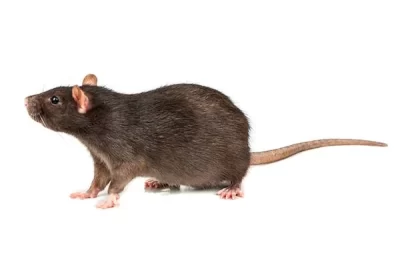Latin Name: Rattus rattus

Rats live in warm areas like attics because it is safe, quiet, and dark. Attic rats are also called root rats which are common in warm areas like in attics. They are also called white-bellied rats or Alexandrine rats, or ship rats. They are usually black, have a sleek coat and long tail. They can climb on the surface, fit in almost any space, and breed very quickly, meaning that in no time, one rat in your attic can become 20 in days. The most common places for them have damaged eaves and vent openings.
Attic rats (Rattus rattus) are 40 cm long (18 inches), though smaller and sleeker than Norway rats. Its fur is smooth and sleek, unlike the Norway rat. They are either black or brown with a black or white underside and have four legs and no antennae. Attic rats have long tails, large ears, and eyes, and pointed noses.
Roof rats are good climbers. They build their nests above ground, unlike other rats that burrow underground. They love to nest their homes in trees, woodpiles, shrubs, and dense vegetation. They also love to build their nests in the upper parts of the house, where it is warm due to rising heat. They love to stay in other home areas: attics, ceilings, garages, cabinets, laundry rooms, walls, patios, and pool areas. Generally, they love to stay in rooms that give them enough moisture and water.
They like to also fit themselves in holes that are as small as one-half inch in diameter. They prefer to stay in high places; hence you will find them on tree branches or power lines to get to the house’s roof.
Rats get to into the house through entry points like gaps in shingles, damaged vent covers, chewing entry holes, and squeezing through cracks. They stay there to protect themselves from predators like owls, cats, dogs, snakes, coyotes, and other rats.
Roof rats are like squirrels in their diet. They like to eat fruits, nuts and are generally omnivores. Roof rats don’t prefer to eat high-protein food and meat scraps. When they are hungry, they want to eat ornamental plants, feeds for chickens, swine and cows, nuts, seeds, paper, tree bark, vegetables in the garden, candle wax, etc. Roof rats like to hoard their food and stash seeds and nuts for later use.
Their water sources are leaky pipes, birdbaths, irrigation lines, pets’ water bowls, air-conditioning condensation drip lines, and saucers under potted plants. They can also chew metal and plastic pipes to get water that could lead to much property damages.
The first sign signifying the activity of roof rats is their droppings. Their droppings are usually about 12 to 13 mm with pointed ends. They leave grease marks along surfaces that show that they have traveled through the surface. An obvious sign is sighting them, either dead or alive. However, you will only see roof fats away from their hiding areas if they have been disturbed.
Other signs are:
The damage caused by roof rats is costly and extensive because they chew electrical wires, damage furniture, and rip insulation. They also spread diseases like salmonellosis and Trichinosis by contaminating pantry foods with their droppings. Roof rats are the primary causing agent of the Bubonic outbreak in the United States.
These pests are common in Florida and transmit disease through bites, droppings, and food contamination. It causes rash, fever, headache, vomiting, muscle and joint pain. They also endanger pets and the home in general by bringing in ticks and mites. They are also prolific at destroying and gnawing on pipe insulation. They can chew on pipes, which can cause water damage. They can also bite wood beams and wires that could cause fire hazards.
If you suspect the activity of rats in your home, inspect the entire house for their droppings. Listen for their scurrying feet and squeaks at night.
The best preventive method you can implement are the following:
If you suspect these pests are in or around your home, give us a call for a Free Home Inspection!
